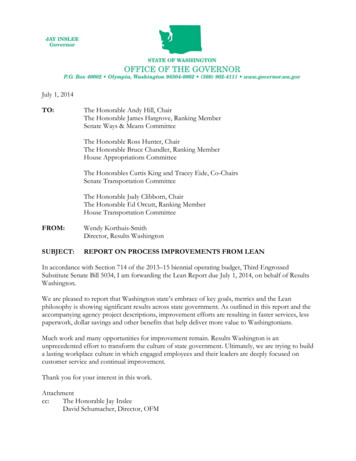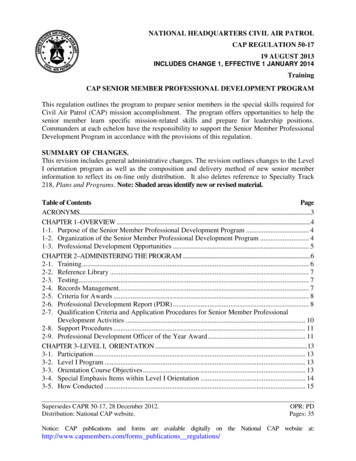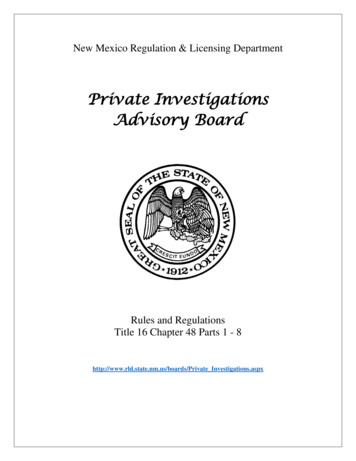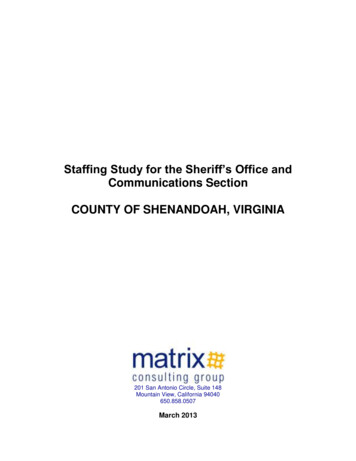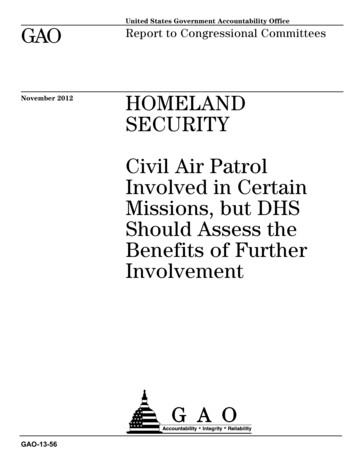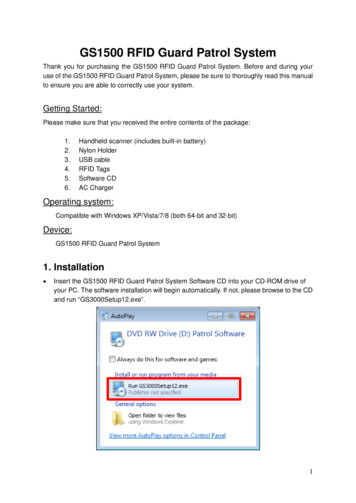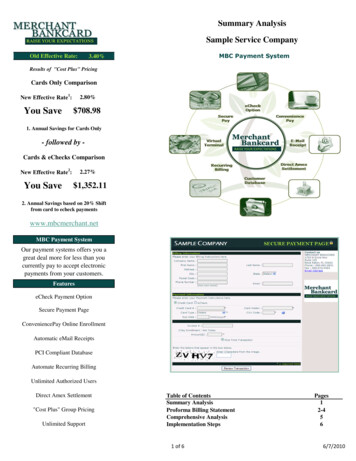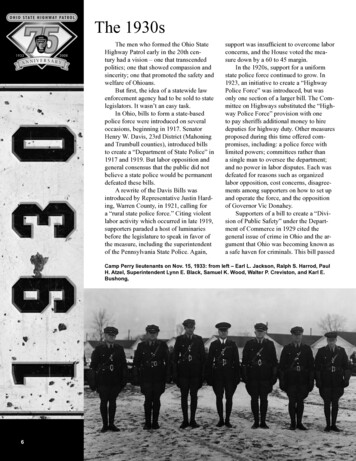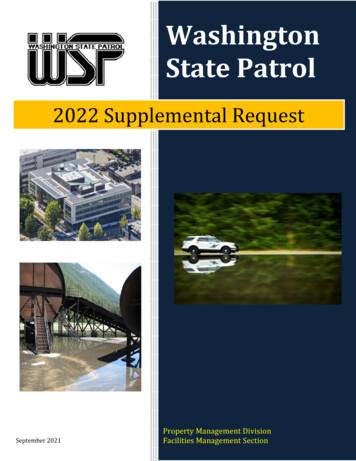
Transcription
00000WashingtonState Patrol2022 Supplemental RequestSeptember 2021Property Management DivisionFacilities Management Section
—(l!ii;;,.JAViNSi.H;fjovn'nor11;.' ' !l,!iji ii :!/:V;.1';]:v;;;:f,l.l, 1WAtji i ii It ;'i« -i i ;;i'\n: ! .' .Wa;i!'ii. toi Si ue P.iii'oi ! lc;nl(ju;iitilrc c' i' .' i ';,; ;.,'h; ' , .;y. . ",September 13,2021Mr. David SchumacherOffice of Financial ManagementPO Box 43113OlympiaWA 98504-3113Subject: Washington State Patrol 2022 Supplemental Capital Budget RequestWe are pleased to submit the Washington State Patrol's (WSP) 2022 Supplemental Capital BudgetRequest for your information and consideration.This request, if enacted, will provide for the WSP's essential needs in meeting its core missions.Please contact me with any questions you may have related to this request.Sincerely,/ - JOHN R. BATISTE :clhEnclosuresec: Mr. Brian W. Bottoms, Property Management DivisionMr. Walter R. Hamilton, Budget and Fiscal ServicesAssistant Chief Scott A. McCoy, Commercial Vehicle Enforcement BureauCaptain Chris D. Old, Property Management Division
2021-2023 CAPITAL BUDGET REQUEST NARRATIVEHistoric Authority StatementEstablished in 1921, the Washington State Patrol operates under the authority of Revised Code ofWashington (RCW) 43.43.010, which created the Agency, and RCW 43.43.030, which gives full policepowers to the officers of the department.The Washington State Patrol (WSP) began formal assistance to other police agencies with the passageof RCW 43.43.500. This statute created the Washington State Crime Information Center. Otherstatutorily required services include the following: The Narcotics Section operates under RCW 43.43.600. The State Crime Laboratory serves all non-federal police agencies in the state and operatesunder RCW 43.43.670. State Fire Protection Services operates within the Washington State Patrol under RCW 48.48 and43.43.930. The Drug Control Assistance Unit (DCAU) was created by the Legislature in 1970 with thepassage of RCW 43.43.600 and 43.43.660. This unit has been renamed the Narcotics Section ofthe Investigative Assistance Division. The Identification and Criminal History Section was established by the 1972 Legislature throughRCW 43.43.700. The Section is the repository for criminal history record information and StateDepartment of Corrections activity based on fingerprint identification. RCW 68.50.310established the dental identification system as a repository for dental records of missing andunidentified persons. The Section also maintains a central registry of sex and kidnappingoffenders as authorized by RCW 9.94A.155. The Legislature expanded the use of criminal history records to include background checks bypublic and private sector employers through the Criminal Records Privacy Act (RCW 10.97),Private Sector Act (RCW 43.43.815), and Child and Adult Abuse Information Act (RCW43.43.830-845). The Child and Adult Abuse Information Act was amended by the 2005 and 2006 Legislatures,removing the responsibility for the Section to maintain and furnish information related todependency and protection proceedings concerning abuse or exploitation of children orvulnerable adults. The Washington Crime Information Center (WACIC), authorized by RCW 43.43.510, containselectronic files of stolen and wanted vehicles, outstanding warrants, missing and unidentifiedpersons, stolen property, protection orders, sex offender registry information and other files ofgeneral assistance to law enforcement agencies. A Central Computerized Enforcement ServiceSystem (ACCESS), authorized by RCW 43.43.785, consolidates criminal justice serviceprograms within the WSP. The Collision Records Section, authorized by RCW 46.52.030, receives reports of vehicles anddrivers involved in collisions resulting in injury or death, or property damage in an amountestablished by the WSP. RCW 43.105.330 established the State Interoperability Executive Committee (SIEC) and its rolein providing oversight to the State’s wireless communications. The Chief of the Washington StatePatrol and the State Fire Marshal are required by statute to sit on the SIEC. RCW 43.43.035 and 43.43.037 mandate the responsibility of the safety of the Governor, theGovernor’s family, the Lieutenant Governor, and for the security and protection of the Legislature. The Washington State Patrol Organized Crime Intelligence Unit (CIU) was created by theLegislature in 1973 with the passage of RCW 43.43.850. RCW 43.43.850 through 43.43.864defines “organized crime” as “activities that are conducted and carried on by members of an
2021-2023 Biennium, Capital Budget Requestorganized, disciplined association engaged in supplying illegal goods and services, and/orengaging in criminal activities in contravention of the laws of this state or of the United States”. The Missing and Unidentified Persons Unit/Missing Children Clearinghouse (MCC) wasestablished in 1985 under authority of RCW 13.60.010. The objective is to maintain and operatea toll-free 24-hour telephone hotline. The MCC distributes information to local law enforcementagencies, school districts, the Department of Social and Health Services, and the general publicregarding missing children. This office also maintains a regularly updated computerized link withnational and other statewide missing person systems or clearinghouses. The WSP Missing and Exploited Children Task Force (MECTF) was created by the Legislature in1999 with the passage of RCW 13.60.100. This multi-agency task force assists law enforcement,state and federal agencies, and the proper custodial parent(s) or guardian(s) by conductinginvestigations on missing, abducted and exploited children through referrals, on-site assistance,case management, and training. The Washington State Patrol Criminal Proceeds Unit (Special Narcotics Enforcement Unit) wascreated by the Legislature in 1989 with the passage of RCW 43.43.655. The Criminal ProceedsUnit’s responsibilities include the investigation of criminal narcotic profiteering investigations,training of undercover narcotic agents, and coordination of federal, state, and local interjurisdictional narcotic investigations. Known as the Teekah Lewis Act, a multi-agency task force within the Washington State Patrolresponds to requests from local law enforcement on missing and exploited children. The taskforce is authorized to assist agencies through case management and referral, technicalassistance, personnel training, and coordination among local, state, interstate, and federal lawenforcement agencies under Chapter 13.60 RCW. The Western States Information Network (WSIN) was established in 1981 by the U.S.Department of Justice through Congressional appropriation for the establishment of regionalintelligence systems throughout the United States. The purpose of this initiative is to formpartnerships between the federal government and local law enforcement. To achieve this goal,WSIN responds to the needs of its member agencies located in five western states (Alaska,California, Hawaii, Oregon, and Washington) by providing a broad range of criminal intelligenceinformation, analytical products, and services in support of gang, narcotic, and Uniform CrimeReporting (UCR) Part 1 criminal investigations and prosecutions. The Criminal Investigations Division (CID), formerly known as the Traffic Investigation Division,operates and receives its authority under RCW 43.43.030. CID was formed on January 1, 1982as part of the Investigative Services Bureau (ISB). The Fuel Tax Evasion Unit has Legislative authority under RCW 82.42.100, RCW 82.36 andRCW 82.38, to investigate fuel tax evasion. The Human Resources Division operates under the authority of RCW 41.06, 41.08, WACChapters 357 and 358, along with Collective Bargaining Agreements with WSPTA, WSPSTA,WSPLA, WFSE, WPEA, Local 17, and the Coalition. The Budget and Fiscal Services Division derives its authority from RCW 43.88: State Budgeting,Accounting and Reporting System (frequently referred to as the Budget and Accounting Act).This statute provides authority and direction for the appropriation, allotment, expenditure,accounting, and reporting of state funding provided for WSP activities. It also defines powers,duties and fiscal responsibilities of Agency officers. The 18th Amendment of the Washington StateConstitution (Article 2, Section 40) authorizes and restricts use of Highway Funds (State PatrolHighway Account), which comprise over seventy percent of the WSP budget. The 11thAmendment to the Constitution (Article 8, Section 4) provides authority for the Agency to incurcosts subject to appropriations by law. RCW 46.61.470 (2) authorizes highway speed enforcement from an aircraft, using a timing deviceto control speed on Washington’s highway system.Capital Request NarrativePage 2 of 9
2021-2023 Biennium, Capital Budget Request RCW 46.61.506 provides the authority for the State Toxicologist to approve instrumentation andprotocols related evidential breath alcohol analysis and evidential blood analysis and othercompetent evidence in determining whether a person was under the influence of intoxicatingliquor or any drug. The Fire Protection Bureau’s Inspection Program has statutory authority to adopt and enforce firesafety standards as outlined in RCW’s 18.120.130 (Boarding Homes), 18.46.110 (BirthingCenters), 18.51.140 (Nursing Homes), 70.41.080 (Hospitals), 71.12.485 (Private Establishments),and 74.15.150 (Child Day Care Centers). The Licensing Program has statutory authority toregulate and provide management oversight of Fire Sprinkler Contractors and their employeesper RCW 18.160 and the Fireworks Industry per RCW 70.77. The Mobilization Section coordinates statewide fire service resources to support local firefightingefforts as required in RCW43.43.961. The Data Collection Unit gathers data for the National FireInformation Reporting System (NFIRS). NFIRS is the nationally recognized standard for reportingfire related incidents. Fire agencies electronically document their incident experience and reportthe information in accordance with RCW 48.48.065. The Publication Education Unit performs thedaily management of the Youth Risk Watch Program, Juvenile Fire Setter Intervention Program,and the Fire prevention Education Program. They also develop and implement the FireworkSafety Education Campaign, as provided by RCW 70.77 and funded through licensing fees. The Hazardous Materials Unit provides hazardous materials training to first respondersthroughout the State of Washington. As directed in RCW 70.136.030, the Washington StatePatrol is designated as the Incident Command agency at any hazardous materials incident on oralong any state route or interstate freeway corridor, as well as within any jurisdiction that has notdesignated an incident command agency. Although not mandated by statute, the Governor’s Committee on Homeland Security, WashingtonAssociation of Sheriffs and Police Chiefs, WSP, and the Federal Bureau of Investigation (FBI)recognized the need for development of a useful anti-terrorism intelligence fusion center. In2003, Washington Joint Analytical Center (WAJAC) was established with the FBI in Seattle, as acentral point (fusion center) for all terrorism-related tips collected by Patrol Officers andDetectives throughout the State. The WAJAC is currently supervised by a WSP InvestigativeAssistance Division Lieutenant and FBI supervisor. It was renamed in 2008 to the WashingtonState Fusion Center (WSFC).Agency Missions and GoalsThe Washington State Patrol makes a difference every day, enhancing the safety and security of ourstate by providing the best in public safety services. The Washington State Patrol achieves their missionof providing and improving the safety and security of the public through the highest standards ofprofessionalism, accountability and continuous performance improvement. The Washington State Patrolis dedicated to providing and enhancing the safety and security of every public citizen through a core ofskilled, well trained and professional work force.Goal 1Make Washington roadways and ferries safe for the efficient transit of people andgoods.Goal 2Reduce our citizens’ vulnerability to fire, crime, terrorism, and natural hazards.Goal 3Meet the growing need for law enforcement, forensic, investigative, and other publicsafety services statewide.Goal 4Leverage technology to enhance and sustain business processes, public safetyinfrastructure and statewide emergency communications interoperability.Goal 5Provide critical leadership, tools and resources to foster an ethical, innovative,knowledgeable, and diverse workforce.Capital Request NarrativePage 3 of 9
2021-2023 Biennium, Capital Budget RequestFacilities Summary and AssessmentThe Washington State Patrol manages over 200 public safety facilities across the state to meet theAgency’s mission and goals. Most of these are complex, special purpose installations, designed andoperated to perform specific functions for the Agency. Such facilities include district offices, detachmentoffices, commercial vehicle enforcement weigh stations, crime labs, training academies, andcommunication resources that total more than one million square feet of space under roof and manyhundreds of acres of associated grounds.As the business needs within these facilities have become more complex, the systems and equipmentwithin the facilities have also increased in complexity. The WSP has been a good steward of its assetsand takes every measure to keep aging systems and equipment in operation. Albeit, the Agencymaintains a tradition of measured capital requests that address only the most pressing Agency needs.This approach is consistent with the limited amounts available through the State Patrol Highway Account(SPHA) where 70 percent of the funds for Agency operations and assets originate.The Agency partitions the state into eight (8) geographic locations, or Districts, for traffic control andenforcement operations. Each district has a headquarters building and several detachment offices, withthree (3) to four (4) working groups assigned to each location. Districts vary in size across the state,resulting in a significant geographic challenge to the facilities and maintenance operations. The majorityof these offices were constructed from 1950 to 1980, requiring greater maintenance and systemreplacements as each facility continues to approach the end of its useful life. As of this year, the averageState Patrol owned facility has been in service over 35 years.Co-locations with other state agencies are reviewed on an annual basis to maximize facility operatingefficiencies and associated expenditures. Examples of past efficiencies include the SunnysideDetachment relocation to the Prosser Scale facility plus the Human Resource Division relocation fromLacey to the Capital Campus Headquarters. The recently created Commercial Vehicle EnforcementBureau focuses interest on the enforcement of commercial vehicle regulations in Washington, which fordecades has been a statutory part of the Agency’s mission. Activities in this bureau (which were at thedivisional level of the Agency previously) direct new resources on motor carrier safety in addition tostraightforward permit, weight, height, width, brake condition and axel spacing concerns that havetraditionally been the Agency’s responsibility.Support for local and state law enforcement agencies is given by the Washington State Patrol’s forensic,fingerprint and toxicology laboratories. Furthermore, these facilities require specialized equipment as anintegral part of the laboratory services provided. The laboratories at Cheney, Kennewick, Vancouver,Tacoma and South Seattle have significantly increased the need for maintenance level support of thesenewer and larger State Patrol facilities. Previously, maintenance requirements and costs for some ofthese facilities were absorbed as lease costs for the forensic laboratories located in Spokane (nowrelocated to Cheney), Kelso (now relocated to Vancouver) and Seattle (now relocated to South Seattle.)In addition, the demand for services continues to increase incrementally with advances in technology.The Agency will be unable to keep up with this need in the future without the expansion of existinglocations and the addition of new facilities. The Seattle, Tacoma and Kennewick laboratories havereached the physical and operational limits of their locations. Regardless of that reality, the chronicscarcity of state resources for capital expansion has made the desire for creation of a third regional crimelaboratory in the Richland area seem impractical. As a result, preliminary plans for such a facility, whichwere completed in September of 2008, have been shelved in favor of conceptualization for a consolidatedreplacement for Tacoma, Seattle and the Olympia Latent Prints Labs in the Tacoma area.Statewide Agency voice and data communication systems continue to rely upon strategically locatedradio transmission equipment sites to provide the Agency with an interoperable statewide emergencycommunications system. This system provides voice communication for the Washington State Patrol, theDepartment of Fish and Wildlife, the Department of Transportation, the State Lottery Commission, theWashington State Gambling Commission, the FBI and other critical local, state and federal lawenforcement agencies. The Agency has developed co-location agreements with private and publicentities for communication tower partnerships in response to recommendation #8 of the 1998 report bythe Joint Legislative Audit Review Committee. The agency continues to seek such partnerships.Two (2) training academies operated by the Agency provide primary, advanced and specialized training insupport of the Agency’s mission. The first is the Shelton Training Academy, which provides critical lawCapital Request NarrativePage 4 of 9
2021-2023 Biennium, Capital Budget Requestenforcement and other related training for both commissioned and non-commissioned personnel. Inaddition, the facility is used by other law enforcement agencies, including forces from other states. TheShelton academy includes an administrative building; classrooms; dormitories; a drive training courseused for training in high speed pursuit maneuvers; a skidpan (used to train emergency vehicle operatorshow to maintain high speed control on slick surfaces); a firearm training range; a K-9 training facility; akitchen/dining hall; maintenance and automotive repair buildings; and a multipurpose building whichhouses three (3) offices, a classroom, a gymnasium for tactical and physical training, and a training tankwith necessary aquatic training equipment. The campus is heavily utilized and will require increasedmaintenance in the future to preserve the quality training currently being provided.A master plan for the entire facility should be completed, to identify and coordinate overall Agency trainingneeds into the future.The second Agency campus is the Washington State Fire Training Academy, located near North Bend,which provides training for firefighters and public safety professionals from local, state and federalgovernments, as well as private fire brigades and the marine industry. This is a unique training facilitydue to its ability to burn Class A fuels (wood) and Class B fuels (gasoline, diesel and aviation fuels) andconsists of several burn props and buildings specifically designed to provide live fire simulation trainingfor beginning and advanced first responders and firefighters. These props are supported by a trainingwaste water recovery system that protects the environment from contamination and provides forsustainable levels of water consumption.The Fire Training Academy (FTA) also provides training courses with simulation props for hazardousmaterial spill cleanup, corrective actions and control operations. This facility is provided with anadministrative building; three (3) classrooms; an instructor resource building and dormitories; a dininghall/meeting room; a domestic water well and drinking water purification building; a training water pumphouse; a vehicle maintenance and storage facility; three (3) water storage ponds; a structure containingequipment to refill fire extinguishers and a medical assistance building. The facility’s environmentalobligations are supported by a comprehensive stormwater collection and treatment system operatingunder an approved National Pollution Discharge Elimination System (NPDES) permit. The most recentcapital projects completed at the FTA include a sanitary system and new dormitory.Many aspects of the FTA academy have deteriorated and are approaching the ends of their useful lives.The centerpiece training prop at the FTA, the six-story burn training building is at the end of its life,costing as much or more to keep operating as would the construction of a new, more state-of-the-artreplacement over its expected life. In addition, there are several modular buildings used for teaching andadministrative purposes that have experienced significant structural decay. These building will needreplacement soon and because of their construction, remodeling will not be an option. Constructiondocuments for a new Burn Building have been completed and we are currently working with King Countyon a new Special Use Permit for the first phase of construction.A Fire Training Academy Master Plan, completed in 2013 has validated preservation, improvements andexpansions at the facility through the 2027-2029 biennium. These recommendations are reflected in thissummary. The Fire Training Academy Master Plan has proved to provide good results for planninginfrastructure improvements and program expansions. Similar master planning efforts are in store for theWSP Academy, a law enforcement training center in Mason County, and for district operations around thestate starting with the District 2 Headquarters at Bellevue. Operating and maintenance recommendationswill be a key part of all of the master planning described above.Current Capital FocusSignificant increases in the responsibilities and operations of all areas of public security and safetyprograms amplify the requirements for capital investments to support the maintenance of Agencyfacilities.The public safety focus of the WSP is directed toward two primary activities: highway safety and lawenforcement; plus fire protection and preparedness. A major aspect of the fire preparedness focus is theoperation of the Agency’s Fire Training Academy near North Bend in east King County. This 52 acrefacility is now over 30 years old and is suffering from age and intensive use. Capital underspending in thepast has created the need to increase the request for generic repairs on campus to 250,000 in theCapital Request NarrativePage 5 of 9
2021-2023 Biennium, Capital Budget Requestupcoming biennium. Other projects identified in the Master Plan will enter the planning and designphases during subsequent periods as a result of delayed requests.As for the highway safety/law enforcement activities of the Agency, continued preservation and repair ofexisting infrastructure is necessary. In addition, significant effort continues with HVAC modernization andenergy conservation to reduce operating costs; plus generator replacement to reduce the cost ofmechanical repairs and improve reliability. Weigh stations, a significant use of funds in the past, will startto be funded through sharing of federal resources with WSDOT. District facilities, however, continue toneed repairs to exterior systems such as roofing, siding, and pavement.2021-2023 Capital Budget RequestFor the 2021-2023 Capital Budget Request, the Washington State Patrol proposed the following additionsand/or improvements:General Fund (State Building Construction Account)1. Fire Training Academy, Burn Building Refractory and Structural Repairs2. Fire Training Academy, Emergency Preservation and Repair3. Fire Training Academy, Access Road – Fish Passage Mandate4. Fire Training Academy, ARFF – Large Plane Prop5. Vancouver Crime Laboratory, Roof Replacement6. Seattle Crime Laboratory, Air Compressor Replacement7. Cheney Crime Laboratory, HVAC Retro Commission8. Kennewick Crime Laboratory, Facility and Security Upgrade9. Crime Laboratories, UPS ReplacementsTransportation Fund (State Patrol Highway Account)1. Statewide Patrol Mission Emergency Preservation and Repair2. Patrol Mission Building Roof Repairs/Replacements (three locations statewide)3. Fuel Tank Decommissioning (three locations statewide)4. Patrol Mission Infrastructure Generator Replacement (seven locations statewide)5. Marysville District Office - Domestic and Fire Water Systems6. HVAC Replacements (five locations statewide)7. Patrol Mission Building Exterior Envelope Preservation (five locations statewide)8. Olympia Detachment and Latent Prints Pre-DesignFuture Capital Budget Request SummaryFor future Capital Budget requests, the Washington State Patrol plans to request the following additionsand/or improvements based on the Agency’s 10-year plan for General Fund Expenditures and 16-yearplan for projects funded through the Transportation Account:Capital Request NarrativePage 6 of 9
2021-2023 Biennium, Capital Budget Request2021-2023 BienniumGeneral Fund Fire Training Academy, Emergency Preservation and Repair: Construction Fire Training Academy, completion of Burn Building Structures: Construction Fire Training Academy, campus emergency power generator: Construction Fire Training Academy, Multi-Services Complex: Predesign Crime Laboratory I-5 Corridor Consolidated Facility: PredesignTransportation Fund Statewide Emergency Preservation and Repair: Construction Statewide Roof Replacement: Construction Statewide Exterior Preservation: Construction Statewide Emergency Generator Replacement: Construction Statewide HVAC Replacement: Construction Statewide Pavement Preservation: Construction Olympia Detachment: Construction Bellevue District Headquarters, Expansion: Bid Documents Shelton Academy, Master Plan: Design Shelton Academy, Kitchen/Dining Hall Addition: Predesign Shelton Academy, Firearms Training Center: PredesignFuture Capital Spending PlanThe increasing demand for public safety and security requires an increase in capital investment tosupport the Agency’s mission. Capital Budget Requests from General and Transportation Funds willinclude the following asset improvements in subsequent biennia:2023-2025 BienniumGeneral Fund Fire Training Academy, Emergency Preservation and Repair Fire Training Academy, Multi-Services Complex: Bid Documents Fire Training Academy, Utility and Illumination Upgrades: Design/Construction Crime Laboratory I-5 Corridor Consolidated Facility: Bid DocumentsTransportation Fund Statewide Emergency Preservation and Repair: Construction Statewide Roof Replacement: Construction Statewide Exterior Preservation: Construction Statewide Emergency Generator Replacement: Construction Statewide HVAC Replacement: ConstructionCapital Request NarrativePage 7 of 9
2021-2023 Biennium, Capital Budget Request Statewide Pavement Preservation: Construction Bellevue District Headquarters, Expansion: Construction Shelton Academy, Kitchen/Dining Hall Addition: Bid Documents Shelton Academy, Firearms Training Center: Bid Documents Shelton Academy, EVOC Expansion: Predesign2025-2027 BienniumGeneral Fund Minor Works Emergency Preservation and Repair Fire Training Academy, Multi-Services Complex: Construction Fire Training Academy, Aircraft Rescue Facility Upgrade: Predesign Fire Training Academy, Marine Training Prop Upgrades: Predesign Crime Laboratory I-5 Corridor Consolidated Facility: ConstructionTransportation Fund Statewide Emergency Preservation and Repair: Construction Statewide Roof Replacement: Construction Statewide Exterior Preservation: Construction Statewide Emergency Generator Replacement: Construction Statewide HVAC Replacement: Construction Statewide Pavement Preservation: Construction Shelton Academy, Kitchen/Dining Hall Addition: Construction Shelton Academy, Firearms Training Center: Construction Shelton Academy, EVOC Classroom: Bid Documents Shelton Academy, Administrative Building: Predesign2027-2029 BienniumGeneral Fund Minor Works Emergency Preservation and Repair Fire Training Academy, Aircraft Rescue Facility Upgrade: Bid Documents Fire Training Academy, Marine Training Prop Upgrades: Bid Documents Fire Training Academy, Arson Investigation Classroom: Predesign Fire Training Academy, Hazardous Material Training Center Upgrades: PredesignTransportation Fund Statewide Emergency Preservation and Repair: Construction Statewide Roof Replacement: Construction Statewide Exterior Preservation: Construction Statewide Emergency Generator Replacement: ConstructionCapital Request NarrativePage 8 of 9
2021-2023 Biennium, Capital Budget Request Statewide HVAC Replacement: Construction Statewide Pavement Preservation: Construction Shelton Academy, EVOC Classroom: Construction Shelton Academy, Administrative Building: Bid DocumentsCapital Request NarrativePage 9 of 9
Washington State Patrol1A Infrastructure Replacement1B2022 Supplemental Capital Budget Request Projects MapSnohomish County:Marysville District OfficeWater System Improvements
August 20, 2020Brian BottomsWashington State PatrolFacilities Section ManagerIn future correspondence please refer to:Project Tracking Code:2020-08-05263Re: Washington State Patrol 2021-2023 Biennium Budget RequestDear Brian Bottoms:Thank you for contacting the Washington State Department of Archaeology and Historic Preservation(DAHP). The above referenced project has been reviewed on behalf of the State Historic PreservationOfficer (SHPO) under provisions of Governor’s Executive Order 05-05 (GEO 05-05). We have reviewedthe materials you provided for the Washington State Patrol Capital Programs Projects for the 2021-2023Biennium.Should projects in the li
Mr. Walter R. Hamilton, Budget and Fiscal Services Assistant Chief Scott A. McCoy, Commercial Vehicle Enforcement Bureau . State Fire Protection Services operates within the Washington State Patrol under RCW 48.48 and . Centers), 18.51.140 (Nursing Homes), 70.41.080 (Hospitals), 71.12.485 (Private Establishments), and 74.15.150 (Child .

